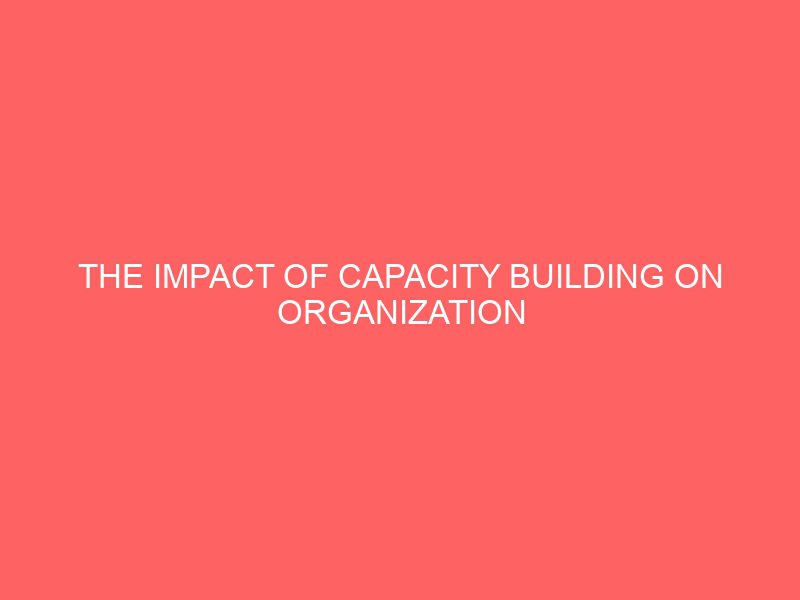Description
THIS RESEARCH WORK IS ON THE IMPACT OF CAPACITY BUILDING ON ORGANIZATION SUCCESS.
Abstract
The term “capacity building” has caught on quickly within the nonprofit sector, specifically with Nongovernmental Organizations (NGOs). In fact, many funding organizations, agencies and foundations are now requesting that their partners engage in capacity building activities. How then, do we determine which organizations have the capacity to adhere to their mission statements and to deliver their services in a sustained fashion? This is an important question for two reasons. First, it asks us to identify the factors which lead to capacity, and second, it suggests that capacity building is a continuous process. This study proposes a relational process of building an organization’s future using Appreciative Inquiry. It supports a greater appreciation and awareness of the importance of building multi organizational and global capacities. The relational capacity building framework introduces definitions, insights and guidelines that help the organization create capacity at different levels as well as define core capabilities. This framework allows organizations to see where they are today and establish a vision for tomorrow. It helps them to clearly understand their directions, views, values and capabilities to create a learning environment for capacity building at the same time they are actively involved in creating their future. In so doing, it offers both utility and value for NGOs, donor organizations, governmental agencies, researchers and policy makers. While predominately donor driven, capacity building cannot be understood by only considering a Northern NGO (NNGO) or donor’s perspective. The issue is driven by the interdependency between NNGOs and Southern NGOs (SNGOs). This study will consider both perspectives and Capacity Building Stavros iii was created from an in-depth analysis of four NNGOs, and data from a thorough literature review and meta-ethnography of six SNGOs. The Global Excellence in Management Initiative (GEM) organization worked with the researcher in the proposal stage to help identify the key research questions and other primary and secondary sources of information. GEM is a university-based program of learning and education that works in partnership with U.S. Private Voluntary Organizations (PVOs) and international NGOs (INGOs) to conduct capacity building programs.
CHAPTER ONE
INTRODUCTION
1.1 CONTEXT OF THE PROBLEM
Survival of most corporate organization is mostly dependent on acquired and developed knowledgeable skills and experience of their employees. The employees are expected to develop along with the contemporary and in response to rapidly growing competition in the corporate world. Change itself has been the most enduring phenomenon and a necessary condition for development for manpower to cope with and adapt to the dynamic nature of our work environment. The need for capacity building in most organization has come to be universally accepted as a vital tool in improve the input of employees including administrators.
The success of most organizations can to a large extent be attributed on the calibre and quality of the employees. No organization, no matter the size and resources can survive without competent and qualified manpower. The need for capacity building of employees in Nigeria becomes more pertinent in view of Nigeria’s quest to develop and industrialize especially since Technological innovations in business today practically renders skills and methods ineffective for tomorrow’s activities.
Similarly, Interest in improving nonprofit management is neither new nor revolutionary. Whether called organizational development, leadership training, technical assistance, management improvement or capacity building, funders have long supported efforts to increase the organizational performance of nonprofits. What is new perhaps is the level of interest in and resources directed toward capacity building.
As nonprofit organizations play increasingly important roles in our society, it becomes even more critical for them to perform effectively. In response, nonprofit managers have demonstrated a growing interest in management practices and principles that will help them build high-performing organizations, rather than just strong programs (McKinsey & Company, 2001).
While the benefits of capacity may be compelling, the actual effort of building capacity can seem daunting indeed. It can be hard for the nonprofit manager to fund, hard to launch, and hard to implement. It takes a long time and the need is not always apparent to staff, volunteers, board members, or donors.
This study intends to focus on the Impact of Capacity Building on Organization Success with particular reference to Non Profit Organizations. The Niger Delta Community Change Network (NDCCN) was chosen as study for this research. This NGO was selected for study because of its nature of business especially since it focused more on capacity building. This was essential in other to have a basis for evaluating the Impact of Capacity Building on organization success. An Organization that is not involved in Capacity Building may not be in a position to provide credible responses to the issues raised.
1.2 STATEMENT OF PROBLEM
Community structures are generally organized around three realms: the government, business, and nonprofit sectors. Like a three-legged stool, all three sectors must be present, sturdy, and working together to achieve balance and stability. However, in today’s rapidly changing environment, there is considerable concern that the third sector—community-based nonprofit entities—may lack the capacity and technical expertise to keep up with change and thereby contribute to an enriched and healthy quality of life. Many small, community-based groups are organizationally fragile. Many large groups are stretched to their limits. As demand for community-based services grows, as new needs are identified, and as new paradigms for exchange and interaction emerge, the nonprofit sector is continually challenged to devise ways to increase and strengthen its capacity. Indeed, capacity building must rest on the notion that change is the norm and not a passing anomaly (Amherst H. Wilder Foundation, 2000 in Carol J. De Vita and Cory Fleming, 2001).
In view of the quest for the industrialization and development of Nigeria as a Nation within the possible shortest time (this brings to mind the goal of the Federal Government’s Vision 20:20:20) on the one hand and the scarcity of qualified manpower on the other hand which has restricted the achievement of these goals, Capacity building becomes imperative.
Quoting Nwachukwu (1988:86) “the emphasis placed by an organization on training and development is emphasis placed on productivity”. Thus, any organization that lays little or no emphasis on training and development (which of course is the bane of most Capacity Building programmes) is encouraging the obsolescence of the employees, inflexibility in operations and in most cases, fails to recognize the changing environment in which it operates. Technological Innovation and environmental changes require that employees are constantly trained and developed to meet the demand of the dynamic situation under which the organization operates.
Donors invest huge sum of money on Capacity Building Programmes which could have easily be invested in acquiring additional equipment or machinery or even advanced technology. Hence it becomes imperatives that these monetary investments in capacity building be justified through proper monitoring and evaluation of the programme.
The success of most Nonprofit to a large extent is dependent on the quality of employees volunteering. It follows therefore that NDCCN’s success is dependent on the qualification and skills of its (personnel) employees.
1.3 THE PURPOSE OF THE STUDY
The purpose of this study is to empirically examine the Impact of Capacity Building on Organization Success. The study aims at achieving the following objectives;
I. To ascertain the extent to which organization fill open positions with qualified (based on competencies, experience) internal candidates from across the organization.
II. To ascertain the extent to which organization provide employees with formal training or learning plans to ensure that they develop the skills they need to do their job.
III. To ascertain the extent to which organization use training and development (for example, skill building, career planning, etc.) to help employees achieve their career goals.
IV. To ascertain if adequate capacity building programmes has any effect on employee turnover.
V. To ascertain the extent to which management commitment and investment in learning and development are consistent with strategy, priorities, and goals of the organization.
1.4 RESEARCH QUESTIONS
1. To what extent does the organization fill open position with qualified personnel’s.
2. To what extent does organization provides employees with formal training to ensure that they develop the skills they need to do their job
3. To what extent does the organization uses training and development to help employees achieve their career goals.
4. Does adequate Capacity building programmes has any effect on employee turn over
5. To what extent does management commitment and investment in training and development and goals of the organization.
1.5 RESEARCH HYPOTHESES
Based on the problem and purpose of this study, the following null hypotheses are postulated for the study;
H01: There is no significant relationship between Capacity Building approach/implementation and Organizational Productivity.
H02: There is no significant relationship between training and Development and employee turnover.
H03: There is no significant relation between the type of employee skills and experiences retained and Market Share of the Organization.
H04: There is no significant relationship between management’s commitment to capacity building and the Organizations’ progression.
H05: There is no significant relationship between the type of training and an employee’s career goal path.
1.6 SIGNIFICANCE OF THE STUDY
This work is significant in that it offers a framework for reaping the full benefits of Capacity Building. The study will offer useful conclusions and the findings will enhance the use and the effectiveness of Capacity Building in Organizations. The study population – Niger Delta Community Change Network (NDCCN), has been carefully chosen because of its wealth of experience in Capacity Building. Their views on the Impact of Capacity Building on Organization Success will be instructive to other organizations in other sectors of the economy. As a developing field of study, this study is expected to further engender the interest of researchers in the field and set the stage for more comprehensive research on capacity building.
This study is also significant in that Capacity Building if properly implemented have been demonstrated to have a major impact on organization performance as well as its overall success. Yet, there is a paucity of research on this construct for Organizations within the Nigeria work environment both in the public and private sector. However, we tend to draw inference from the works of researches on this subject done in other countries. But we do know that what may hold for organizations in other countries may not entirely be the same in this part of the world. Hence providing such data could offer managers insight to better direct strategies for improving the efficacy of Capacity Building within an organization and in turn affect overall success of the organization.
1.7 SCOPE OF THE STUDY
The study covers only the management and members of the Niger Delta community change network it also uses the medium to touch some other organizations that has issue on under study but with particular reference to the above mentioned organization.
1.8 LIMITATIONS OF THE STUDY
There is a deficiency of literature and research on Capacity Building, particularly in the Nigerian context. Most of the available literature is by foreigners on foreign companies, whose settings in no way depict what obtains in Nigerian organizations.
Owing to the time available and the cost implications to execute a research of this nature, findings from this research may not be exhaustive.
These limiting factors are expected to affect the generalizations made in this study. Nonetheless, knowledge to be gained on the Impact of Capacity Building on Organization Success will make the study worthwhile.
1.9 ORGANISATION OF THE STUDY
This study is divided into five chapters. Chapter one provides an introduction to the study wherein a background to the study is provided. The contexts of the problem, statement of the problem, purpose of the study and research questions are also presented in this chapter. Chapter one is rounded up with the hypotheses, significance of the study, definition of terms and limitations of the study.
Chapter two contains the review of relevant literature on the study. It discusses Organizational Success and the concept of Capacity Building. There is also an extensive discussion on the Impact of Capacity Building and Organization Success.
In Chapter three, the methodology used in the conduct of the survey is presented. A presentation of the research design and model for the study are presented. The sampling procedure, sample size determination and data collection method are presented. The operational measures of the variables, test of validity and reliability and data analysis techniques employed are also included in this chapter.
In Chapter four, data collected are presented and analyzed using the ‘Chi Square’ (x2), ‘Spearman Rank Order Correlation Coefficient’ (rs) and ‘Person’s Product Moment Correlation Coefficient’ (rp) statistical test by utilizing the SPSS software. The significance of the obtained values was also provided by the software in its output view.
Finally, in chapter five, research findings are discussed. Conclusions on the Impact of Capacity Building on Organization Success are drawn and recommendations provided.








Reviews
There are no reviews yet.